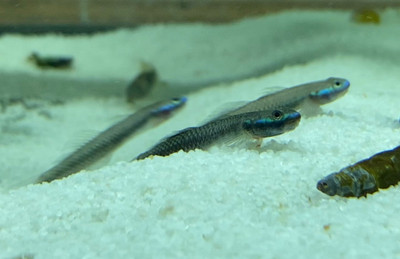Electric Blue Goby: Stiphodon
Posted by Max Gandara on on 15th Jan 2025
The Enchanting Electric Blue Goby: Stiphodon
The aquatic world is brimming with fascinating creatures, but few are as captivating as the Electric Blue Goby, scientifically known as Stiphodon. These small, vibrant fish are not only a visual delight but also play a unique role in their ecosystems. Let's dive into the world of the Electric Blue Goby and discover what makes them so special.
A Splash of Color
The Electric Blue Goby is renowned for its striking appearance. Their shimmering, iridescent blue scales make them stand out in any aquatic environment. This vibrant coloration is not just for show; it serves as a form of communication and camouflage within their natural habitats.
Habitat and Distribution
Electric Blue Gobies are typically found in the fast-flowing streams and rivers of Southeast Asia, particularly in regions like Japan, Taiwan, and the Philippines. They thrive in freshwater environments with clean, well-oxygenated water and rocky substrates. These habitats provide them with ample hiding spots and a rich supply of food.
Behavior and Diet
These gobies are known for their peaceful and social nature. They often form small groups and are rarely aggressive towards other species, making them a popular choice for community aquariums. Their diet primarily consists of algae and small invertebrates, which they graze off rocks and other surfaces in their environment.
Importance in Ecosystems
The Electric Blue Goby plays a vital role in maintaining the ecological balance of their habitats. By consuming algae, they help prevent overgrowth, which can disrupt the balance of aquatic ecosystems. Moreover, their presence indicates a healthy water system, as they require clean, well-aerated environments to thrive.
Breeding and Lifespan
Breeding these gobies in captivity can be challenging, as they require specific conditions to encourage spawning. In the wild, they migrate to brackish waters to breed. Once the eggs hatch, the larvae are swept downstream to the ocean, where they grow before returning to freshwater environments. In captivity, simulating these conditions can be difficult, but successful breeding can lead to a rewarding experience for aquarists.
Caring for Electric Blue Gobies in Aquariums
For those interested in keeping Electric Blue Gobies as pets, it's important to replicate their natural habitat as closely as possible. Here are some tips:
- Tank Size: A tank of at least 20 gallons is recommended to provide ample space for swimming and grazing.
- Water Conditions: Maintain a temperature between 72-78°F with a pH of 6.5-7.5. Ensure the water is well-filtered and oxygenated.
- Substrate: Use a sandy or rocky substrate to mimic their natural environment and support their grazing behavior.
- Diet: Provide a varied diet of algae wafers, blanched vegetables, and high-quality flake or pellet food.
Conclusion
The Electric Blue Goby, with its dazzling appearance and gentle nature, is a magnificent addition to any aquarium. Their presence not only enhances the visual appeal of aquatic setups but also contributes to the health and balance of their ecosystems. Whether you're an experienced aquarist or a beginner, these enchanting fish are sure to captivate and inspire.

